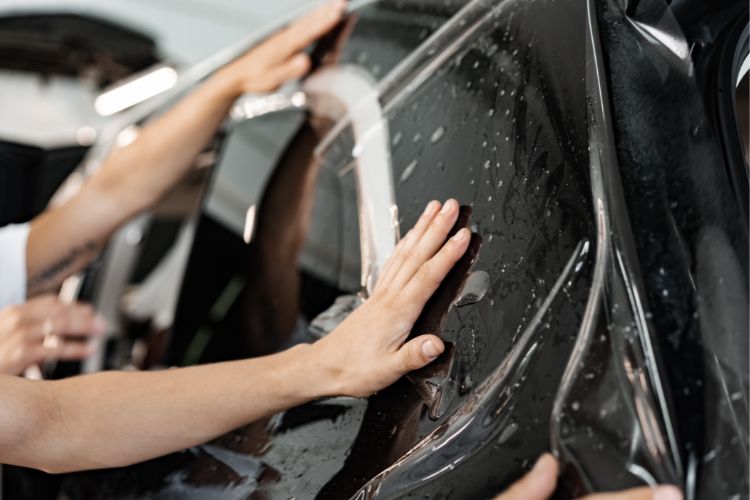Car Stickers: Ensuring Quality from Design to Installation
In a world where small details reflect our taste and personality, car stickers have emerged as one of the most popular expressive tools. Whether used to showcase your logo, add an artistic touch to your vehicle, or convey a specific message, the quality of design and printing plays a fundamental role in ensuring the final result. But how can you guarantee your car sticker meets high-quality standards? This is what we’ll explore in detail below.
First: Why Prioritize Car Sticker Quality?
While stickers may seem simple, they’re more than just images or words on a car. Low quality can lead to rapid peeling, color fading, or even damage to the car’s paint. High quality, however, ensures an elegant appearance that lasts long and enhances the vehicle’s visual value.
Second: Characteristics of a Well-Designed Car Sticker
1. Clarity of Concept and Simplicity
The design should be instantly clear. Colors shouldn’t be overwhelming, and fonts shouldn’t be so complex they hinder readability. Visual balance between text and graphics is crucial.
2. Dimensional Harmony with the Surface
A common mistake is printing stickers sized inappropriately for their designated car area. Designers must know the exact dimensions of the application surface to avoid distortion or disproportion.
3. Color Suitability for Outdoor Use
Colors that look vibrant on screens may appear faded or unclear when printed—especially under sunlight or outdoor lighting. Use print-optimized colors compatible with open-air lighting conditions.
Third: Printing Quality Standards
1. Printer Type
Car sticker printers must be industrial-grade, capable of handling heat-, moisture-, and UV-resistant materials. Home printers may work temporarily but won’t endure long-term.
2. Print Resolution (DPI)
Higher resolution (measured in DPI—Dots Per Inch) ensures sharper details and superior output. The ideal resolution for car stickers is 300 DPI or higher.
3. Adhesive Material
The sticker’s base material must withstand weather conditions. Vinyl is the optimal choice—it’s water-resistant, durable, and resists peeling or fading.
Fourth: How to Test Sticker Quality Yourself
1. Durability Test
Before full installation, test a small piece on a hidden car area. Expose it to sun and water for a few days to evaluate adhesion and color resilience.
2. Texture Check
High-quality stickers have a smooth, uniform texture. Low-quality ones may feel rough or uneven.
3. Transparency and Shrinkage
Cheap stickers may turn transparent or shrink after application, distorting their shape. Premium stickers maintain dimensions and color stability over time.
Fifth: Tips for Choosing a Design & Printing Company
1. Review Past Work
Request samples of previous projects to assess design style, execution precision, and visual quality diversity.
2. Request a Proof
Before final printing, insist on a digital or physical proof to catch color, size, or placement issues.
3. Inquire About Materials
Ask about the vinyl type, printer model, inks, and protective coatings. Ensure materials are designed for outdoor use and climate resistance.
Sixth: Professional Installation Steps
1. Clean the Surface
Thoroughly clean the area with specialized products to remove dust and oils. A clean surface ensures stronger adhesion.
2. Use Specialized Tools
A rubber squeegee is essential to eliminate air bubbles and achieve a smooth, uniform finish.
3. Gradual Application
Start from one edge, using the squeegee to press the sticker down gradually. Avoid applying it all at once to prevent wrinkles or creases.
Seventh: Post-Installation Care
- Wait 48 hours after installation before washing the car to ensure full adhesion.
- Use cold water and mild detergents; avoid harsh chemicals or steam washers.
- Gently clean the sticker—avoid scrubbing to prevent damage to printed layers or edges.
Eighth: When to Replace Your Sticker
Even with premium quality, stickers don’t last forever. Replace them if you notice:
- Faded colors or lost gloss.
- Peeling edges or torn surface layers.
- Visible bubbles or cracks.
Ninth: Temporary vs. Permanent Stickers
Tenth: Key Questions to Ask Before Ordering
- Is the design print-ready?
Screen-optimized designs may not translate well to large-format printing. - What materials are used?
Request details on vinyl type, laminate, adhesive, and protective coatings. - Is there a warranty?
Reputable providers offer limited guarantees against fading/peeling. - What’s the turnaround time?
Confirm timelines for design, printing, and installation—especially for deadlines. - Can I see a proof or sample?
A physical/digital preview prevents costly errors.
Conclusion
Stickers are more than decorations—they reflect your personal or professional identity. The difference between a standard sticker and a professional one lies in quality, from design to installation. By prioritizing details and choosing carefully, you’ll ensure a long-lasting sticker that elevates your car’s aesthetics.









